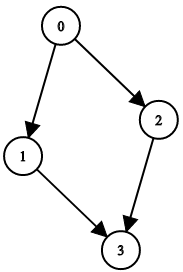这道题我个人认为非常经典,在评论区看了大神的代码,自己5分钟就手写了一遍,问题的难点从来都不是代码,而是在思路。
当我拿到这个题目时想分析有哪几种异常情况,分析发现根据这些异常情况判断比较复杂,很难较全面的判断。
比如
Input: n = 4, leftChild = [1,-1,3,-1], rightChild = [2,3,-1,-1]
Output: false
我开始以为leftChild和rightChild中不能有重复元素,但问题远比这种情况复杂。
Input: n = 2, leftChild = [1,0], rightChild = [-1,-1]
Output: false
这种场景也没有重复,但是存在多个root结点,因此也不合法。
正确的解法分为两步:
1.找到唯一root(如果不唯一 false)
2.DFS或BFS统计结点个数是否与传入参数一致,如果不是合法二叉树,个数必然不一致。
使用这种方法问题就变得非常非常简单。
class Solution {
public:
bool validateBinaryTreeNodes(int n, vector<int>& leftChild, vector<int>& rightChild) {
vector<int> inDegree(n,0);
int root = -1;
//遍历左右子树,更新所有结点入度
for(int i = 0;i < leftChild.size();i++)
{
if(leftChild[i] != -1 && inDegree[leftChild[i]]++ == 1)
return false;
}
for(int i = 0;i < rightChild.size();i++)
{
if(rightChild[i] != -1 && inDegree[rightChild[i]]++ == 1)
return false;
}
for(int i = 0;i < inDegree.size();i++)
{
if(!inDegree[i])
{
if(root == -1)
root = i;
else
return false;
}
}
if(root == -1) return false;
return count_node(leftChild,rightChild,root) == n;
}
private:
int count_node(vector<int>& l, vector<int>& r,int root) {
if(root == -1) return 0;
return 1 + count_node(l,r,l[root]) + count_node(l,r,r[root]);
}
};